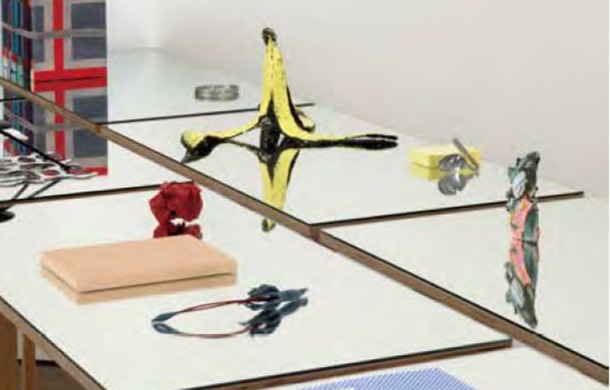HEMAN CHONG IN COLLABORATION WITH ANTHONY MARCELLINI: INTERVIEW(S)
| May 10, 2013 | Post In LEAP 19

If Heman Chong had dedicated himself entirely to writing, by now he would most likely be stuck in its tight and unmarketable shackles, hanging around dingy dive bars bemoaning his plight to a bunch of good-for-nothings. Luckily, there are plenty of readymade forms beyond the written word able to bear the weight of his intense creative desires and narrative urges. The exhibition “Interview(s),” in collaboration with Anthony Marcellini at London’s Wilkinson Gallery, takes the form of a collection of identical, mirrored tables, on which are placed strange objects. These create a long, revolving “paragraph” to be read slowly by the viewer, albeit not without plenty of provocative and free logical leaps between the lines.
The stuff of these “interviews” was not revealed in advance; instead, both artists first separately collected 100 objects, then on meeting, compiled and paired them together. The outcome appears similar to Marc Saporta’s work of ergodic literature Composition No.1: narrative fragments printed onto pages which are left unbound. To experience the story, the reader reads then re-shuffles the pages, and the composition of the novel thus constantly changes; also, due to the process of reading this imposes, the reader’s mind automatically generates logical connections between the fragments of text. Indeed, if one of East London’s infamous “h**sters” was to run away with one of the objects on display here, the direction of the whole story could well be transformed.
On their websites, both Heman Chong and Anthony Marcellini list themselves as writers as well as artists; their shared infatuation with literary forms is also the basis of their collaborative relationship. In 2011, the pair produced a radio play together, titled Public Allergies, which relates the tale of an artist who creates great turmoil with a public art project in Broadway Market (East London). In this piece, which borrows from the tradition of scriptwriting and works with conventional narrative storytelling, it is difficult to identify each artist’s mark; the two blend in imperceptibly in with each other. In this exhibition, their chosen channel of expression is the readymade: Chong contributes a few neat “stacks” of book-like canvas, some circular jewelry, magazine pages modified with symmetrical patterns; amongst Marcellini’s contributions are a large sculpture of a banana skin, small toy animals, colored balls of paper… on first glance, due to their apparent randomness and indistinguishability, they appear more like mere fragments of clues, but, on closer inspection, each object in some way exposes the identity of its owner— a preference for symmetry, a slight sense of innocent self-pity.
To their two shared creative identities, Heman Chong has added another, that of the curator. The significance of this lies in an expanded world of possible readymades— namely, in Chong turning other artists or art-world participants into readymades and applying them to his own creative projects, strengthening his sense of control. In 2007, Chong gathered a group of eight people: critics, curators, designers and artists, who over a period of one week collectively wrote a science-fiction novel titled PHILIP. Even earlier, in 2005, Chong was commissioned to hold an extravagant party for the Singapore pavilion of the Venice Biennale… Even though he often uses his work’s sense of design, or literariness, to express a sense of loneliness, this loneliness is more comparable to the kind found in The Great Gatsby. In contrast, Marcellini’s temparement is more of the Alice In Wonderland variety, the kind of quiet sentimentality easily evoked by very ordinary objects. In a 2012 work Slowly Breathe in…and Out…Through the Object, Marcellini sets into motion interaction and exchange between the participants and the rusted steel objects which they hold in their hands, momentarily part of themselves. So, in this collaboration, although Marcellini’s contributions, based as they are on experience, are more easily perceivable, Chong’s reliance on surveillance as established in past projects leaves one ultimately feeling that the leading role he usually occupies in these has come to disrupt the equilibrium needed in this one. (Translated by Dominik Salter Dvorak)


